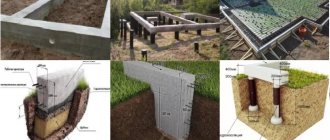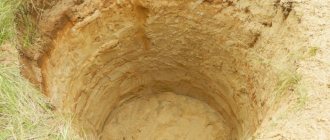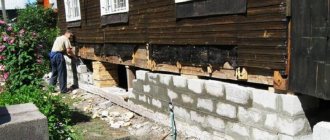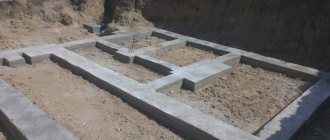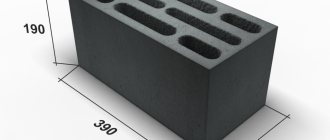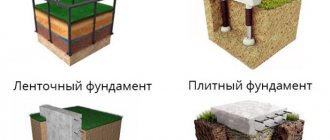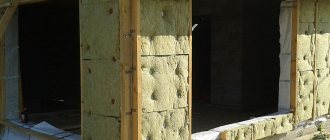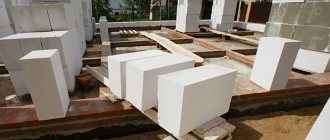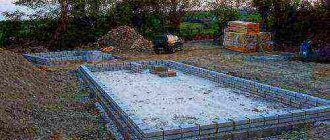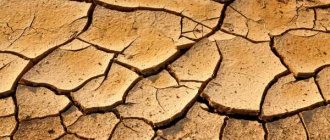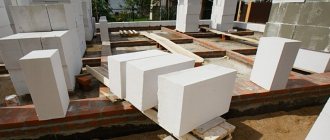Expanded clay concrete blocks are widely used in private construction, including in the construction of individual residential buildings, garages and other auxiliary buildings due to their low cost and good technical parameters. But the foundation made of expanded clay concrete blocks is often criticized by professional builders. What does this have to do with?
Production of houses from block building materials
There are two technologies for constructing buildings from expanded clay concrete - monolithic pouring and in the form of blocks. The first method is too expensive and not convenient to use, so it is not used in private construction. Block elements are in demand among developers, so they should be considered in more detail.
Making blocks
To prepare porous block building materials, a solution is used in a ratio of 1:2:3 - cement (it is better to use the M400 brand, which has good binding properties), sand, expanded clay. The production of porous bricks has a number of nuances:
- Expanded clay has the properties to absorb moisture well. When making blocks, you should first make a small batch of mortar to determine the amount of water needed to achieve the optimal consistency of the mixture;
- One of the features of porous pebbles is that they are light and float to the surface of the water. The solution should be mixed thoroughly so that all granules are well covered with sand-cement slurry;
- fine-grained rock is used to make block elements;
- The molded material hardens within 3 weeks.
When the porous building material dries well, you can move on to laying out the walls.
Features of buildings made of expanded clay concrete
The inexpensive cost of the material reduces the cost of constructing low-rise buildings and high-rise buildings with a monolithic frame structure. Expanded clay concrete is chosen due to its advantages:
- low thermal conductivity, thanks to which it is possible to build thick wall structures that do not create a load on the sole;
- vapor permeability, promoting a comfortable microclimate inside the home;
- good soundproofing and noise insulation performance;
- the strength of clay elements, eliminating the load on the base;
- environmental safety, fire resistance and durability.
The use of expanded clay concrete material reduces the costs of constructing residential buildings. The blocks are used for finishing facades, interior work and organizing fundamental structures.
Disadvantages of houses made of expanded clay concrete blocks
- The porosity of expanded clay concrete blocks is both a plus and, in turn, a minus for the house. Because of this, they absorb water very well, and when the temperature drops below zero, this water begins to crystallize, destroying the structure of the block, thereby harming the entire house as a whole. Therefore, you should not use expanded clay concrete blocks without additional protection from environmental influences, facing bricks, for example. Although almost all materials of this type suffer from this disadvantage.
- Due to its small size, there will be a lot of seams in the masonry, which, in turn, let the cold into the house very well. Therefore, it is impossible to do without additional insulation of the walls from the outside. But this is a disadvantage of most wall materials.
- If we compare a house made of expanded clay concrete blocks and, say, gas silicate blocks, then the second one will have less thermal conductivity, with the same wall thickness. And this can also be written down as a minus.
- Another minor disadvantage is that manufacturers of expanded clay concrete blocks do not have much choice in size, there are only ordinary ordinary 390x190x188mm and semi-blocks, which differ only in thickness 90 and 120 mm, respectively. This does not allow you to specifically choose the thickness of the walls of the house, either 19 cm or 39 cm.
Recently, more and more often defects appear on the construction market, this applies not only to expanded clay concrete blocks, but given that these blocks can be made in any “garage”, in our case this problem becomes even more urgent, and this can be done count it as a minus. To avoid such cases, before purchasing, it is advisable to come to the place where these blocks are produced and personally make sure that they are manufactured in strict compliance with the technology. Only then will you protect yourself 100%.
Conclusions and tips for building a house from expanded clay concrete blocks
From all of the above, I think we can conclude that houses made of expanded clay concrete blocks have a right to exist. In such a house you can live in warmth and comfort, with proper insulation of the walls. Plus, overall it will cost you relatively little, and all the disadvantages inherent in this material can be minimized or even eliminated by observing the technology and features of the masonry.
Here are some tips from experts to help you avoid serious mistakes:
Do not leave the walls of a house made of expanded clay concrete for a long time without external finishing; as I already said, their structure will collapse and the strength of the entire house as a whole will significantly decrease. Pay special attention to waterproofing the walls of the house; without proper waterproofing, the walls in the house will get wet, especially the lower outer corners, which can lead to the appearance of mold. Despite the fact that this is an easily accessible material, it is still necessary to calculate the expanded clay concrete blocks for your home so as not to overpay for delivery. In the central and northern regions, you should not use expanded clay concrete blocks to build a house without additional insulation of the walls. Although they are warm, they are not that warm. Although in some cases you can do without an armored belt, all the same, if funds allow, it is better to install it on top of expanded clay concrete walls. You should not build any foundation from expanded clay concrete blocks, no waterproofing will help you there, blocks in the ground will collapse in a very short time
In some cases, they are used to build a basement, but even then they are solid.
In addition to everything, it is worth noting that in order for a house made of expanded clay concrete blocks to become a warm and cozy home for you, it is not enough just to find high-quality material, it is necessary to carry out its high-quality installation. Therefore, if you are not able to do it yourself, then you need to hire highly qualified and proven specialists.
Phased construction of the basement
Work on the construction of a plinth made of expanded clay concrete blocks is carried out in the following sequence:
First of all, a layer of roofing material is laid out, which will act as horizontal waterproofing. In principle, here you can choose any roll-type waterproofing material, but roofing felt is best suited. Next, we prepare the concrete solution in accordance with the instructions. The solution must fully meet the requirements for laying expanded clay concrete blocks. A regular cement-sand mortar may not be suitable. Laying the first row should begin from the corner of the structure. First, the first row is laid along the perimeter of the building, after which a metal reinforcing mesh is placed on the blocks. It is recommended to take a mesh with a cell size of 50x50 mm. Then we apply the solution to the first row of blocks and lay out the second row according to the same pattern. It should be noted that small holes (windows) must be made in the masonry of the base for ventilation. The holes should be located in increments of 2.5–3 meters, the size of each window should be 20x20 cm
Often, windows for ventilation of the ground floor or basement are made in the third row of masonry (this is optional). After the installation of the second row is completed, attention should again be paid to waterproofing. Again we take roofing felt and carry out horizontal insulation of the basement structure (it is recommended to lay roofing felt in two layers). The third row is laid using mortar (reinforcing mesh is not used here)
After laying the third row, the metal mesh is installed again. Finally, the fourth row of blocks is laid. Once all installation work has been completed, final horizontal and vertical waterproofing must be done. This time you will need to insulate the entire base part. As a rule, bituminous materials and mastics are used for vertical waterproofing. The choice of one or another waterproofer will depend on the specifics of the work, the capabilities and wishes of the owner of the house. It is recommended to use traditional hot bitumen mastic, which is applied in two layers. After the vertical one, you need to do horizontal waterproofing again: glue the roofing material to the top of the base (again in two layers). The final stage is to install waterproofing over the entire subfloor area. Any sheet-type insulating material can be used here. The sheets should be laid overlapping each other by 10–15 cm. A ten-centimeter layer of sand is poured on top and thoroughly compacted.
For the construction of the base, solid expanded clay concrete should be used (photo courtesy of the site skb21.ru).
It should be noted that this work is not as simple as it might seem at first glance. Therefore, if you do not have proper experience in carrying out construction work, then it is best to entrust the matter to professionals. If you have some experience, then you will not find anything complicated in laying expanded clay concrete blocks. By and large, this is very similar to standard brickwork, although there are some characteristic features that must be taken into account when carrying out work of this type.
The main advantages of houses made of expanded clay concrete blocks
Let's start with the main advantage of houses made of expanded clay concrete blocks - the thermal conductivity of the walls. Houses built from such blocks retain heat very well inside themselves, if, of course, the technology for both production and installation of the blocks is followed
This happens thanks to the porous filler - expanded clay. The second, but no less important advantage is the low weight of the expanded clay concrete block. In addition to the fact that expanded clay itself is a very light material, hollow expanded clay concrete blocks additionally have some voids, the size and quantity of which depend on the manufacturer, and make up about half the volume
Taking this into account, the walls of the house will be light, which will have a very good effect on the foundation under the house as a whole. Despite the fact that expanded clay concrete is a relatively lightweight material, its strength and durability, proven over the years, are the envy of most modern and expensive building materials. And don’t look at the fact that each block individually looks fragile and breaks at the slightest fall or impact. In the wall of a house, expanded clay concrete blocks are so strong that they can withstand almost any load of low-rise construction, be it floor slabs, various types of purlins, lintels, etc. One of the most important advantages of houses made of expanded clay concrete blocks is the cost compared to other materials, both the cost of the blocks themselves and their masonry. Thanks to this, such houses will never lose their popularity among developers. During the operation of the house, if its walls were lined with high-quality material, the appearance of cracks and microcracks in the walls is unlikely, unlike aerated concrete, for example. This happens because blocks made of expanded clay concrete are less susceptible to shrinkage. The main advantages of using a house include the fact that the walls of the house, built from expanded clay concrete blocks, do not emit any harmful substances, because all the components from which they are made are environmentally friendly. Expanded clay has very good soundproofing properties, thereby the entire house as a whole will be well insulated from extraneous external noise (not counting windows, of course). Due to their lightness and small size, expanded clay concrete blocks are very easy to install, which has a positive effect on the cost of building a house as a whole. By the way, laying walls from expanded clay concrete blocks is not difficult to do with your own hands. Plastering a house built from expanded clay concrete blocks, even with an ordinary cement-sand mixture, is a pleasure. The solution sticks to them very well, which not all wall materials can boast of. This will also allow you to save a little on finishing work.
An advantage, albeit insignificant, is that thanks to the simple and low-cost manufacturing technology, as well as popularity, expanded clay concrete blocks can be purchased in almost every city and even small village, which will allow you to save on delivery.
So we looked at the main advantages of houses made of expanded clay concrete blocks; as we see, there are a huge number of them, which makes them very popular. But, as you know, they have not yet come up with the “ideal” material, everyone has their disadvantages, and expanded clay concrete is not deprived of them, although it does not have so many of them.
Selection of foundation
When choosing the type of foundation for a house made of expanded clay concrete blocks, it is necessary to take into account the depth of freezing of the ground and the topography of the site. It is also necessary to know the level of groundwater, the level of street noise and almost everything else.
This selection must be done especially painstakingly in areas with constantly frozen soils or on slopes. For walls made of gas silicate blocks, a special glue is used, which has excellent adhesion and thermal insulation properties. On this type of soil, it is unsafe to build houses from expanded clay concrete blocks, unless it is a slab one.
Due to the large area, the load on the soil in this case is distributed moderately along all fronts. The soil experiences virtually no pressure. Foundation made of FBS blocks, turnkey price in St. Petersburg. This makes it possible to erect any buildings on a slab foundation. Foundation for a house What kind of foundation is needed for a house made of walls made of aerated concrete blocks. But due to the size of the slab, this is not very comfortable to do, especially when building from blocks.
And, in general, it’s not worth chasing after far-fetched savings. It is better to entrust the construction of a house from expanded clay concrete blocks and the foundation for it to qualified specialists. They will select the type of foundation base appropriate to the area.
The use of expanded clay concrete for the construction of a block base
The hygroscopicity coefficient of expanded clay concrete is only 3% of the total mass. For example, the hygroscopicity of ordinary brick is 6-10%, concrete up to 15%, and foam and aerated concrete up to 22%. Accordingly, this material is ideal for constructing prefabricated foundations.
Foundation made of expanded clay blocks, insulated with foam plastic and lined with bricks
Work on geodetic alignment of the house, soil sampling and installation of a sand and gravel cushion is carried out by analogy with a poured foundation. If the soil is sandy, then simply compacting the bottom of the pit is allowed. The construction of the foundation is carried out in complete analogy with the laying of walls from the same material. The blocks are laid on ordinary cement mortar with the seams bandaged at 0.5 heights. The permissible height of such a base should not exceed 5 rows.
Advantages and disadvantages of a prefabricated strip foundation made of expanded clay concrete blocks
Advantages:
- High resistance to groundwater;
- Resistance to sudden, significant and frequent temperature changes. Minimum coefficient of thermal expansion of the entire structure;
- Can be installed on any type of soil;
- High speed of work compared to pouring;
- The average specific weight of the blocks allows installation without the use of heavy, specialized construction equipment.
Flaws:
- Shrinkage processes in a prefabricated foundation are more pronounced than in a monolithic foundation;
- A large volume of soil must be sampled.
Such foundations are allowed as the basis for a one-story house made of expanded clay concrete with an attic.
Selection of foundation
When choosing the type of foundation for a house made of expanded clay concrete blocks, it is necessary to take into account the depth of freezing of the ground and the topography of the site. It is also necessary to know the level of groundwater, the level of street noise and almost everything else.
This selection must be done especially painstakingly in areas with constantly frozen soils or on slopes. For walls made of gas silicate blocks, a special glue is used, which has excellent adhesion and thermal insulation properties. On this type of soil, it is unsafe to build houses from expanded clay concrete blocks, unless it is a slab one.
Due to the large area, the load on the soil in this case is distributed moderately along all fronts. The soil experiences virtually no pressure. Foundation made of FBS blocks, turnkey price in St. Petersburg. This makes it possible to erect any buildings on a slab foundation. Foundation for a house What kind of foundation is needed for a house made of walls made of aerated concrete blocks. But due to the size of the slab, this is not very comfortable to do, especially when building from blocks.
And, in general, it’s not worth chasing after far-fetched savings. It is better to entrust the construction of a house from expanded clay concrete blocks and the foundation for it to qualified specialists. They will select the type of foundation base appropriate to the area.
Foundation for a one-story house made of expanded clay concrete blocks
Is it possible to lay a foundation of expanded clay concrete blocks for a residential building? Theoretically, no, but in practice you can meet it much more often than it seems.
The main problem of expanded clay block is that it is a relatively light wall stone, and not at all a foundation material with high strength and wear resistance. Here is what the large manufacturer of expanded clay concrete blocks, Cheboksary Stroykombinat, says about their use:
1.4. Wall blocks made of expanded clay concrete are intended for laying external and internal walls of buildings with a relative indoor air humidity of no more than 75% in a non-aggressive environment.
1.5. The use of blocks made of non-hydrophobic expanded clay concrete, as well as blocks with voids for laying walls in wet rooms, as well as in places where increased moisture of concrete is possible, is allowed provided they are reliably protected from moisture by using high-quality vapor and waterproofing.
Due to their light weight, expanded clay concrete block foundations can be built in a short time. The construction technology is quite simple.
Before construction begins, the site is cleared of debris. Then they dig a trench 30-40 cm deep, at the corners of which support pillars are placed. Formwork consisting of reinforcement and wooden boards is placed in the trench. Then expanded clay concrete blocks are laid deep into the trench. It is better to lay them in layers, alternating expanded clay concrete with solid brick. At this stage, it is necessary to take care of waterproofing the foundation - this will significantly extend the life of the entire structure. The expanded clay concrete foundation must be reinforced with an armored belt, which is a reinforced concrete strip: it is laid in several layers along the block base.
In the video below you can see a real review of laying a foundation made of expanded clay concrete blocks.
Calculation of house weight
To calculate the weight of a house to choose the optimal type of foundation, you need to find the area of the building itself, the basement and attic floors, the roof and multiply by the weight of the selected building materials.
For example, a one-story house 5x8 m with a wall height of 3 m and one internal wall will have the area:
Foundation calculation
To calculate the concrete for pouring a monolithic foundation slab, you need to multiply the area of the building by the desired thickness of the foundation, which can be at least 10-15 cm. Therefore, for a house with an area of 40 m², we will need at least 400 m³ of concrete to build a slab foundation.
The cross section of the slab will be 0.1×0.1=0.01 meters. Let's find the required volume of concrete mixture equal to, multiplying the cross-sectional value by the length of the slab edge - 47 m, we get:
Briefly about the main thing
Which foundation is better for a house made of expanded clay concrete blocks? There is no definite answer to this question: houses made from the same building materials can be radically different from each other, as well as the opinions of developers about their characteristics, purpose or appearance. One thing is undeniable - the strength of the building depends on the quality of the foundation. For example, solid expanded clay concrete blocks with a strength of M100 and higher, of course, can be used to build the foundation of a small one-story house, provided that a high-quality product has been selected and the laying technology has been followed. This option is beneficial in terms of budget and time: there is no need to wait for ripening, as is the case with a poured foundation. However, expanded clay wall blocks are categorically not suitable for a foundation if we are talking about building a house with several floors - the expanded clay block is simply not designed for such a load, and in this case, laying a poured strip foundation or buying FBS blocks is much more profitable and safer for residents .
In addition, at the stage of designing a building and selecting a foundation, it is necessary to take into account such related factors as the quality of the soil, its characteristics, the presence and degree of aggressiveness of groundwater, the climate of the area, the type of building and its purpose. The cost of construction work is also an important factor. Soundly assess your requirements and capabilities, choose trusted manufacturers and suppliers of building materials. Only in this case the construction will not turn into a disaster, and you will end up with a full-fledged home for a comfortable stay.
What to consider in the project
The process of digging a trench for the foundation
The strength and functionality of the future garage is determined by the following initial conditions:
- The basis of the foundation. The properties of the soil supporting the structure will affect the stability of the support, waterproofing device, and the amount of materials. With a fertile layer thickness of 10-40 cm, a depth of 0.5 meters is selected (add 20 cm per bed) until a dense layer of clay or other source rocks is reached below the washout level.
- Size. Depending on the size of the machine, the height and width of the room are selected. The usable area takes into account a minimum space of 1.5 m to the left of the car, 1 m to the right, up to 3 m at the rear. The height of the walls and the type of roof affect the calculated load-bearing capacity of the initial lower level.
- Communications. The strength of the structure is maintained provided that openings are made for the passage of pipelines and networks simultaneously with the laying of wall material. Punching holes in an established monolith results in cracks and damage to the insulation. Large foundation blocks made of expanded clay concrete are made with technological cutouts.
- Compatibility. An attached garage made of expanded clay concrete blocks needs to be tied to an existing building. The foundation for a cinder block garage must bear its load on its own without negatively affecting the main building. Option – the intention to build an auxiliary room in a complex with a garage in the future. A solution is required to link the future structure.
The use of expanded clay concrete composite elements in the structure solves problems in each of these points. When constructing a foundation, this is chemical stability in soil with different environments (acidic, alkaline), the ability to maintain strength on swelling soils, as well as the ability to maintain the geometry of vertical and parallel lines. When independently solving the problem “How to calculate the foundation for a garage?” are guided by SNiP 2.02.01-83, approved in 2011. The supplier (manufacturer) of the expanded clay concrete block can indicate in the service design and construction work, a turnkey package. Openings of the required size and laying in the desired configuration are easily accomplished during laying.
Construction technologies
So, depending on the type of construction of a house made of expanded clay concrete blocks, the foundation is selected.
Tape
The strip foundation can be either prefabricated or monolithic
It can be either prefabricated or monolithic. Monolithic has many advantages, since it minimizes the need to use special equipment. In this case, the width of the tape must be no less than the thickness of the wall panels to create a strong support and prevent displacement of the axis of the blocks and the base.
The material requirements are as follows:
- concrete grade B20-25;
- reinforcing bars A400;
- backfill made of medium sand;
- for tape with shallow or deep immersion, provide insulation materials.
Columnar base
It can be made of concrete blocks or be monolithic. A mandatory grillage is provided to ensure uniform distribution of the load on all elements.
Slab base
It is equipped with reinforced concrete monolithic slabs. For private buildings, slabs with a cross-section of up to 300 mm, class B20-25 concrete, and A400 reinforcement are used. Reinforcement frames are required, as is pouring in one go, which will increase the reliability of the entire structure.
Piles
To build a house from blocks with your own hands, it is better to choose bored piles
They can be screw or bored. To build a house from blocks with your own hands, it is better to choose bored piles, which increase the strength of the entire structure, but screw pile elements will reduce excavation work and deepen them much faster and easier. It is necessary to arrange a grillage, which is best made of reinforced concrete, but an ordinary metal one can also be used.
When choosing a foundation for a building made of blocks, it is necessary to clearly understand the characteristics and capabilities of the soil. Only with correct calculations will it be possible to avoid mistakes and make the foundation truly strong. Do not forget about insulating the underside of a house made of blocks if the choice fell on pile or slab foundations. Experts recommend choosing the latter option, but you can use strip types of foundations, provided the soil quality at the construction site is acceptable.
How to make a columnar foundation with your own hands: step-by-step instructions
Before starting all work, it is necessary to study the soil foundation, determine the groundwater level, and also make a qualitative calculation of the required number of support pillars and their design options. Only then can you begin preparing the construction site.
Video about how you can make a columnar foundation with your own hands:
Calculation
In order to correctly perform the calculation, you can hire qualified specialists for this, or use special computer programs.
Thanks to an accurate calculation, you can obtain the required number of pillars, their cross-sectional area, as well as the required depth. The calculation usually shows a minimum number of supports: if you perform them in smaller increments, this will allow you to build a more reliable structure.
The photo shows drawings of a columnar foundation with dimensions:
Excavation
First, it is necessary to remove the fertile layer of soil from the site. On average, this size is 20 centimeters. Next, you need to designate the installation locations of the support pillars. With the help of a drill, wells of a certain depth and size are made. To better arrange the markings of the future system, you can use a geodetic theodolite.
Installation of pillows under pillars
By pillow we mean a layer of sand, the thickness of which is usually no more than 30 centimeters. After backfilling, the sand must be compacted. In most cases, a small cross-section log is used to perform this stage of work.
Sand removes excess ground moisture from the support pillars. Next, a concrete layer is made, with a thickness of 10 to 30 centimeters. It serves as a support for the future structure.
Execution of formwork
When performing formwork, it is worth considering the type of soil. If the construction site has clay soil, then the construction of formwork may not be necessary, since the clay does not collapse. If the soil is sand, then this structure is made of wooden boards or similar flat materials. In the first option, the obligatory technology will be the laying of roofing felt in the wells. It will serve not only as walls, but also as waterproofing.
If natural wood is chosen as the material for formwork, then experts recommend thoroughly moistening it with water. Otherwise, it will absorb moisture from the concrete solution, thereby worsening its quality characteristics.
Reinforcement
Reinforcement of support pillars is mandatory, since it is this that holds back the loads. Iron reinforcement is cut into pieces of the required size and tied together into a frame
In this case, it is very important to stack the individual products relative to each other. The frame is lowered into the well exactly in the middle
Only after this can concrete be poured.
Pouring concrete
When pouring concrete mortar, it is necessary to tap the formwork to remove excess air and create high-quality pillars. Concrete mortar with standard mixing should consist of one part cement, two parts sand, and three parts crushed stone. The pillars must not be touched for 28 days. Only after this will they have the necessary strength.
Waterproofing
Since individual elements are threatened by soil and atmospheric moisture, it is very important to perform high-quality waterproofing of the pillars. The structure is usually protected from surface moisture by a blind area
You can also use moisture-proof concrete.
A waterproofing layer, which can be made of roofing felt, must be placed on top of the pillow. The walls of the pit should also be protected with waterproofing material.
Insulation
Insulation from the outside is more common, as it preserves the strength of concrete, does not allow cold to enter the house, and is also an additional protection against moisture. This stage of work can be performed using polystyrene foam, penoplex, and extruded polystyrene foam. A layer of insulation must be placed on the base and around the supports themselves.
Device technology
The foundation for any building is an important part, the construction of which must be taken with the utmost seriousness. To make a load-bearing structure from expanded clay concrete with your own hands, you need to stock up on strength, time and certain knowledge. You can lay CB blocks on a ready-made adhesive solution purchased at a hardware store, or on a homemade mixture of cement, sand, expanded clay and water. Beginner developers are advised not to use block masonry, but simply fill the formwork with ready-made mortar. To carry out the work you will need the following materials and tools:
- reinforcing mesh;
- wooden boards;
- roulette;
- roofing felt;
- shovel.
Having drawn a drawing and determined the parameters of the future structure, you need to clear the area of debris and carry out markings. Next, they place pegs and stretch a rope between them. The next stage is digging a trench along the entire perimeter of the future foundation, at least 30 cm deep, and installing wooden formwork. After this, a reinforcing mesh is laid out, fastened with wire, and insulating material is laid on the walls.
Pouring and shrinkage
Expanded clay concrete is evenly distributed and leveled, not forgetting to vibrate it with reinforcement or a special vibrating device. If you need to lay blocks, then start laying from the corners, carefully pouring the prepared solution between them. In this case, the armored belt is laid on top of the laid expanded clay blocks, and the waterproofing is attached to the outer side wall of the foundation strip. In order for the foundation of the building to be strong and last for many decades, it is necessary to ensure that the newly laid mortar completely hardens. The design bureau acquires maximum strength characteristics after 30 days.
Characteristics of expanded clay
Expanded clay block is the final product of processing low-melting clays by firing. As a result, a porous building material is formed, which has a number of unique properties that are in demand in the construction industry.
Technical qualities of the material
Expanded clay block is characterized by the following indicators:
- high strength – 50-150 kgf/cm²;
- good noise and heat insulation. Block walls made of expanded clay concrete do not require additional insulation;
- resistance to aggressive environmental influences;
- increased fire resistance and resistance to moisture.
The volumetric mass of the porous material is comparable to wood, for this reason the building can be erected on various types of foundations.
Expanded clay fractions
Loose expanded clay is divided into the following fractional types:
- expanded clay sand – fractions from 2-5 mm. It is used in construction work - laying a sand bed, for filling aquariums, for constructing drainage.
- crushed stone – large multi-faceted pebbles with sizes ranging from 0-5 mm, 5-20 mm, 20-40 mm, 40-70 mm, 40 – 200 mm. It is used in road construction, equipment for children's playgrounds, landscaping, and room decoration.
- gravel – oblong granules from 5 mm to 70 mm. Natural material is used to build foundations, backfill sites, make roofing materials, and build highways.
The raw materials have different sizes, which ensures wide application in various fields.
Poured strip foundation
Poured strip foundations occupy a leading position in low-rise private construction. Their installation is a rather labor-intensive and time-consuming process, but if you have access to specialized construction equipment (rent), the construction time can be reduced significantly.
The main stages of work on the construction of such a foundation are:
- Geodetic works. The soil type, groundwater level and freezing depth are determined;
- Linking to the site and marking trenches;
- A sample of land is being sampled, the width and depth comply with the standards of SNiP -87 “Earth structures, foundations and foundations”;
Pit for strip foundation
- If the depth of groundwater is below 2 m from the freezing horizon, then the sufficient depth of the monolithic foundation is 0.6-0.7 m. If less, then it is necessary to make a trench 20 s deeper than the freezing level.
- Collapsible wooden or metal panels can be used as formwork.
- Reinforcement is made from 10-12mm reinforcement, welding or tying it in such a way that the spatial frame is 3-5cm narrower than the outer wall.
- Filling is carried out with a cement-sand mixture of grade M250-300, onto a previously poured and compacted sand and gravel cushion.
Advantages and disadvantages of a strip filler base
Advantages:
- Great reliability, long service life. This is the only acceptable option if a two-story house is being built from expanded clay concrete blocks;
- Allows you to create a garage, a spacious basement or a full room on the ground floor;
- It is installed on clay soils with a high level of freezing. Does not squeeze out, gives minimal shrinkage.
Strip foundation ready for wall construction
Flaws:
- Large material costs;
- Long device time;
- High labor intensity and large volume of excavation work.
This is interesting: How to choose an electrical panel for an apartment - what you need to know
Hydro- and thermal insulation
Regardless of the construction method, the foundation needs proper waterproofing. It consists of covering all the walls around the perimeter inside and outside with hydrophobic substances. This can be a coating - mineral or bitumen mastic, or insulating membranes: roofing felt or adhesive film.
The waterproofing design for each type of foundation is individual.
- Floor with thermal insulation layer.
- The foundation is monolithic.
- Horizontal waterproofing layer. It is applied to the sand and gravel bed before the pouring process. It consists of two layers of roofing felt glued together with bitumen mastic.
- A compacted sand and gravel base or concrete pad to be used when necessary on shifting ground.
- Thermal insulation board - polystyrene foam or polyurethane foam. It is used not only for thermal insulation, but also to protect the waterproofing film from damage during the pouring process.
- Vertical waterproofing.
Foundation insulation method 2
- House wall.
- Floor slab.
- Block foundation.
- Gutter made of waterproof cement.
- Horizontal waterproofing.
- Sand pillow.
- Drip pan for condensate drainage.
- Thermal insulation layer made of extruded polystyrene foam or mineral wool.
- Vertical external waterproofing. It consists of two layers of glued roofing material or a special polymer membrane. When laying it, part of the material should be folded onto the blocks of the upper platform.
- Insulation for the floor above the basement.
Features of the material
Expanded clay concrete has been used in construction for a long time. Most of the domestic housing stock is an example of this. During the construction of standard panel buildings, the external elements were made from this material in order to retain heat in the apartments. Another issue is that the thickness prescribed was insufficient (according to old standards), and in such houses it can be cool in winter.
The main characteristics of the material of the walls of the house, which are important when designing and building with your own hands, are as follows:
- the mass of the walls (which depends on their width and density);
- resistance to base movement.
It is worth talking about each of them in more detail.
Block weight
Everything is simple here, the less the load on the foundation of the house, the less money and effort will have to be spent on it. For each material, the optimal wall thickness is selected according to the joint venture “Thermal Protection of Buildings”. It is in this document that formulas are given for calculation based on the required heat transfer resistance of the structure. To compare expanded clay concrete with other materials, you can see the table below.
| Material for building walls of a house | Density | The width of the wall based on considerations of thermal protection (average value, taking into account the reduction factor mp = 0.63, adopted according to clause 5.2 of the SP “Thermal protection of buildings”. | Weight of one linear meter of a wall of a house 3 m high (average floor height when building with your own hands) |
| Solid ceramic brick | 1800 kg/m3 | 64 cm | 3456 kg |
| Foam concrete blocks (for load-bearing walls) | 900 kg/m3 | 50 cm | 1350 kg |
| Expanded clay concrete blocks | 1000 kg/m3 | 80 cm | 2400 kg |
| Tree | 520 kg/m3 | 30 cm | 470 kg |
The table shows that the use of expanded clay blocks does not significantly reduce the load on the foundation compared to a brick one, so when choosing and building with your own hands, you should focus on supports specifically for brick walls. The situation is similar for walls made of cinder blocks. But, if there is a choice between these two materials, preference should be given to expanded clay, since it is more environmentally friendly. In the production of expanded clay blocks, clay fired in a special way is used, and waste from various areas of industry can be used for cinder blocks, and it cannot be said with certainty (without additional research) that they are safe for humans.
Shrinkage resistance
A wall made of any small materials does not accept movement of the base. Fastening elements together with glue or masonry mortar does not guarantee that a solid structure will be formed. Expanded clay blocks and cinder blocks are lightweight concretes that work well in compression, but are not able to cope with bending, which is what occurs when the foundation is displaced.
Shrinkage cracks are possible if the foundation is not designed correctly.
When building with your own hands, it is important to provide a reliable foundation that will work as a single structure and transfer the loads from the house to the ground
Is the choice justified?
Before choosing what to support a building on, you need to consider the following characteristics:
- load on the foundation from overlying structures;
- soil strength on the site;
- soil tendency to frost heaving;
- location of the groundwater level.
Load
The load depends not only on the material of the walls, but also on the number of floors being built. So for a one-story building it will be enough to provide one type of foundation, but for a two-story building a more powerful foundation will be required.
A one-story house requires one type of foundation, while a two-story house requires something more reliable.
If you take into account only the load, then you should consider options for building with your own hands one and two floors for expanded clay concrete blocks of different densities. For convenience, the data is summarized in a table.
| Block Density | Number of floors of the house | |
| Single storey | Double decker | |
| 1000 kg/m3 | Depending on the geological conditions, shallow strip, slab, or pile foundations are suitable. The section of the tape can be either T-shaped or rectangular. To save money, screw piles can be used. Also, for this type of structure, shallow or deep columnar supports can be used. Non-buried foundations (pillars and strip) can be used on soils with good characteristics. Non-buried slab can be used for DIY construction without fear. | The mass of the walls in this case makes the use of piles economically unprofitable, since they will require frequent steps, a large cross-section and a powerful grillage. It is better to focus on such options as:
It is highly not recommended to use columnar foundations due to their low load-bearing capacity. |
| 700 kg/m3 | Under these conditions, construction on piles is possible, but it is worth performing a preliminary calculation and collecting the load from all the building structures on the foundation. As a guideline value, you can use the fact that one pile (both screw and bored) can withstand an average of 4-6 tons. It is also worth considering options for strip and slab foundations. |
We invite you to familiarize yourself with a sauna in the basement of a private house with your own hands. Before construction, it is important to carry out a calculation of the load-bearing capacity. It differs for different types, but necessarily includes the following steps:
- study of geological conditions and determination of soil types;
- load collection;
- carrying out calculations (calculating the thickness or width of the foundation, calculating reinforcement, determining the depth of piles).
Let's consider two types of materials - FBS (foundation wall blocks, usually used in the construction of basements), and a standard solid block measuring 20x20x40 cm (width, height, length). Expanded clay was used as a filler, respectively, both types of blocks are expanded clay concrete.
As a rule, foundation blocks of various types and sizes are produced in factories. In this case, they have a number of advantages over homemade concrete made at home. But it is worth noting that for laying large factory-made expanded clay FBS, construction equipment will be required.
If the properties and features of the relief are favorable, then developers choose FBS.
Expanded clay concrete support
For the foundation of a block house, you can use expanded clay concrete porous building material. The budget option for constructing a support has a number of practical properties:
- characterized by increased wear resistance. The porous structure of the material is durable, which guarantees the durability and quality of the structure.
- excellent thermal insulation qualities of the building material. The design does not require additional insulation.
- Expanded clay concrete bricks retain their shape during temperature changes, which guarantees the integrity of the base.
- completely safe for humans, environmentally friendly.
- installation is carried out with your own hands, without the use of additional equipment.
Arranging a supporting structure from a porous block is a good solution not only for one-story buildings, but also for buildings with several floors. A block foundation requires effort and time to lay out. But its use will provide a residential building with a reliable and durable foundation. To build your country house using expanded clay concrete blocks, you should resolve the issue of arranging the foundation. The choice of a certain type of foundation is the key to the reliability of the entire construction.
vote
Article Rating
